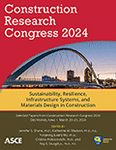Evaluating Utility Data Reliability: A Comparison of One Call and Subsurface Utility Engineering (SUE) Records
Publication: Construction Research Congress 2024
ABSTRACT
This study investigates the accuracy of utility records by comparing available utility records derived from traditional records research such as One Call systems and Subsurface Utility Engineering (SUE) Utility Quality Level B (QLB) investigations conducted as defined by the ASCE 38-22 standards. Focusing on a case study in South Dakota, a “linear foot” metric was developed to quantify discrepancies and assess missing utility records. The findings revealed significant disparities in documented utility linear footage between the two methods. SUE QLB investigations consistently identified a more significant extent of utilities. This underscores the necessity of incorporating SUE practices early in the project development stages to ensure accurate utility data. Hence, this study emphasizes the potential of SUE investigations in enhancing the efficiency and risk management of construction projects.
Get full access to this article
View all available purchase options and get full access to this chapter.
REFERENCES
Al-Bayati, A. 2021. Infrastructure Damage Prevention Approaches in the United States. 102–108.
Al-Bayati, A. J., L. Panzer, and K. Kaddoura. 2020. “Minimizing Underground Infrastructure Damages: Utility Locators’ Perspectives.” Pipelines 2020, 387–391. American Society of Civil Engineers Reston, VA.
Anspach, J. 2019. “Mitigating Existing Utility Uncertainties and Risks.” Mil. Eng., 111 (723): 73–75. Society of American Military Engineers.
Anspach, J. H., and C. P. Scott. 2019. Subsurface Utility Engineering for Municipalities. American Society of Civil Engineers.
ASCE 38, N. 2022. Standard Guideline for Investigating and Documenting Existing Utilities. American Society of Civil Engineers.
Cai, J., S. Li, and H. Cai. 2018. “Accurate mapping of underground utilities: An information fusion approach based on Dempster-Shafer theory.” Constr. Res. Congr. 2018, 712–721.
CGA (Common Ground Alliance). 2021. “Damage Information Reporting Tool (DIRT) Report- Analysis and Recommendations.” Common Ground Alliance CGA Damage Inf. Report. Tool DIRT. Accessed June 12, 2023. https://commongroundalliance.com/Portals/0/DIRT%20Report%202021%20-%20FINAL1.pdf?ver=2022-11-30-165941-267.
Farrag, K., and M. Guerrero Merino. 2022. “An Assessment of Utilities Locating Practices and Excavation Damage.” Int. Pipeline Conf., V003T04A018. American Society of Mechanical Engineers.
FHWA. 2018. “Subsurface Utility Engineering.” - Util. Program - Des. - Fed. Highw. Adm. Accessed July 23, 2022. https://www.fhwa.dot.gov/programadmin/sueindex.cfm.
Geoff Zeiss, S. S. 2016. “Reducing Damage to Underground Utility Infrastructure during Excavation.” Accessed July 13, 2022. https://gita.memberclicks.net/assets/FINAL%20White%20paper_%20Reducing%20Damage%20to%20Underground%20Utility%20Infrastructure%20during%20Excavation%20V5-2-2.pdf.
Hu, W. 2021. 3D Reconstruction of Exposed Underground Utilities Using Photogrammetric Methods. thesis. Toronto Metropolitan University.
Jaw, S. W., and M. Hashim. 2014. “Urban Underground Pipelines Mapping Using Ground Penetrating Radar.” IOP Conf. Ser. Earth Environ. Sci., 18 (1): 012167. https://doi.org/10.1088/1755-1315/18/1/012167.
Jeong, H. S., D. M. Abraham, and J. J. Lew. 2004. “Evaluation of an Emerging Market in Subsurface Utility Engineering.” J. Constr. Eng. Manag., 130 (2): 225–234. American Society of Civil Engineers. https://doi.org/10.1061/(ASCE)0733-9364(2004)130:2(225).
Jung, Y. J. 2009. “Utility impact rating with subsurface utility engineering in project development.” Can. J. Civ. Eng., 36 (11): 1744–1754. NRC Research Press. https://doi.org/10.1139/L09-102.
Jung, Y. J. 2012. “Evaluation of subsurface utility engineering for highway projects: Benefit–cost analysis.” Tunn. Undergr. Space Technol., 27 (1): 111–122. https://doi.org/10.1016/j.tust.2011.08.002.
Kramer, S. W., and A. E. Cady. 2022. “Subsurface Utility Engineering: A Call to Action for Construction Project Owners.” Proc. Creat. Constr. E-Conf. 2022. https://doi.org/10.3311/ccc2022-013.
Kraus, E., K. Obeng-Boampong, and C. Quiroga. 2012. “Utility Investigation Trends in Texas.” Transp. Res. Rec., 2309 (1): 209–217. SAGE Publications Inc. https://doi.org/10.3141/2309-20.
Lew, J. J. 2000. Cost Savings on Highway Projects Utilizing Subsurface Utility Engineering.
Lew, J. J., and J. H. Anspach. 2010. “Utility Risk Management Education for Engineers.” W099-Spec. Track 18th CIB World Build. Congr. May 2010 Salford U. K., 85.
Li, S., H. Cai, D. M. Abraham, and P. Mao. 2016. “Estimating features of underground utilities: Hybrid GPR/GPS approach.” J. Comput. Civ. Eng., 30 (1): 04014108. American Society of Civil Engineers.
Osman, H., and T. El-Diraby. 2007. “Implementation of subsurface utility engineering in Ontario: cases and a cost model.” Can. J. Civ. Eng., 34 (12): 1529–1541. https://doi.org/10.1139/L07-066.
Rogers, C. D. F., C. G. Overton, A. G. Cohn, S. R. Pennock, C. H. J. Jenks, J. M. Muggleton, E. Rustighi, P. R. Atkins, K. Y. Foo, and J. Cross. 2012. Mapping the underworld. Engineering and Physical Sciences Research Council (ESPRC).
Siu, K. L., and W. W. Lai. 2019. “A lab study of coupling effects of electromagnetic induction on underground utilities.” J. Appl. Geophys., 164: 26–39. Elsevier.
Sterling, R. L. 2000. Utility locating technologies. Federal Laboratory Consortium.
Sterling, R. L., J. H. Anspach, E. N. Allouche, J. Simicevic, C. D. Rogers, K. E. Weston, and K. Hayes. 2009. Encouraging innovation in locating and characterizing underground utilities.
Sturgill, R. E., K. Madson, J. H. Anspach, and M. Decker. 2022. Implementation of Subsurface Utility Engineering for Highway Design and Construction. Washington, D.C.: Transportation Research Board.
Sturgill, R., T. Taylor, and Y. Li. 2018. Implications of State Departments of Transportation (DOTs) Participation in the One Call Process as an Underground Facility Operator.
Yasmin, N. 2013. Introduction to AutoCAD 2014 for Civil Engineering Applications. Sdc Publications.
Information & Authors
Information
Published In
History
Published online: Mar 18, 2024
Authors
Metrics & Citations
Metrics
Citations
Download citation
If you have the appropriate software installed, you can download article citation data to the citation manager of your choice. Simply select your manager software from the list below and click Download.
